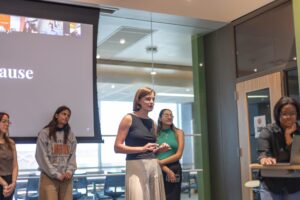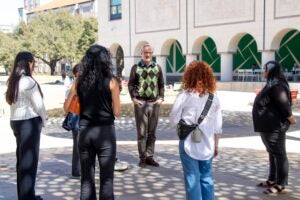AUSTIN, Texas —Visitors to the spectacular new Visualization Lab in the Applied Computational Engineering and Sciences (ACES) building are met with a mind-boggling display of technology similar to the surround theater experience at EPCOT at Walt Disney World.
The Vislab, as it is called, has the makings of a fine movie theater. But it’s built for mind-boggling research of greater significance — such as saving the world from nuclear accidents or finding oil underneath the earth’s surface.
It’s all part of the Center for Computational Visualization in the Texas Institute for Computational and Applied Mathematics (TICAM), an interdisciplinary unit that supports research and postgraduate study in computational engineering and science and computational and applied mathematics.
Within the darkened 2,900-square-foot lab, images are beamed onto a 10-foot high, 180-degree cylindrical screen. The images come from three front projectors and a multiple screen rear projection system driven by 10 projectors.
The graphics generator for the lab is a 24-processor SGI Onyx2 Supercomputer and a 128-node Compaq graphics workstation supercluster.
If it sounds powerful, it is; and it’s one of only a handful of such research labs in academia in the United States. Visualization labs also are found in industry, National Science Foundation supercomputing centers and at U.S. Department of Defense and Department of Energy facilities.
Images on the Vislab’s super-screen are larger than life and can be manipulated and explored using a joystick attached to the supercomputer. A human skeleton can be rotated and examined from every conceivable angle. An entire galaxy can be viewed from various ranges.
Events that occur in a fragment of a second — like an explosion — can be slowed to any pace. And similarly, events that occur over centuries — such as geological change — can be sped up.
At UT, research focuses on the advance work leading up to actual physics simulations on supercomputers. Scientists at the Center for Computational Visualization develop ways for computers that power visualization labs to handle massive amounts of data and calculations. Their work also enables interactivity with this data, in a way similar to interactivity with a personal computer.
For example, in the field of forensics, it is now possible to simulate in three dimensions a bomb explosion. However, conducting such a simulation would require hundreds of millions of equations.
“We develop adaptive methods so the same simulations can be handled with significantly fewer equations — say two million,” said Dr. J. Tinsley Oden, TICAM director.
In a separate project, TICAM researchers are working with the Department of Energy on ways to safely store and protect the nation’s nuclear stockpile. DOE has the job of making sure nuclear weapons can withstand time, earthquakes, fire, radiation and countless other scenarios.
“It’s going to take years of high risk, challenging research to achieve the goals of this mission,” Oden said.
Dr. Chandrajit Bajaj, director of the Center for Computational Visualization, said UT is working on ways to enable such high-risk research.
“We are developing software and hardware tools that make it feasible to explore large amounts of data on very large display screens,” Bajaj said.
“We’re helping DOE visualize massive amounts of data — to analyze that data, visualize what it represents and then explore it further,” Bajaj said, referring to the Vislab’s ability to handle interrogation — or extract highly accurate quantitative information — during simulations.
The accuracy required to support such interrogations is far greater than what is required for visual display. This technology is very new in the world of visualization research, he said. Since computers are built for computing and not for visualization, the work at TICAM is adding a new dimension to computer productivity.
Visualization research can produce extremely practical results. Computer simulations of such events as a vehicle collision with a wall or an obstacle can help manufacturers in auto design. And replications of underground contamination from chemical and oil spills can aid in cleanup efforts.
A key aspect of the UT research focuses on the reliability of computer-generated predictions. In essence, scientists are working on highly complex technological tools to validate the mathematical and scientific data used to develop simulations. Study also is focusing on verification –determining if the final tool can function as it was intended. “Without some confidence in the accuracy of simulations, their value is obviously diminished,” Oden said.



